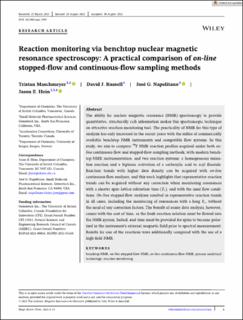| dc.description.abstract | The ability for nuclear magnetic resonance (NMR) spectroscopy to provide quantitative, structurally rich information makes this spectroscopic technique an attractive reaction monitoring tool. The practicality of NMR for this type of analysis has only increased in the recent years with the influx of commercially available benchtop NMR instruments and compatible flow systems. In this study, we aim to compare 19F NMR reaction profiles acquired under both on-line continuous-flow and stopped-flow sampling methods, with modern benchtop NMR instrumentation, and two reaction systems: a homogeneous imination reaction and a biphasic activation of a carboxylic acid to acyl fluoride. Reaction trends with higher data density can be acquired with on-line continuous-flow analyses, and this work highlights that representative reaction trends can be acquired without any correction when monitoring resonances with a shorter spin–lattice relaxation time (T1), and with the used flow conditions. On-line stopped-flow analyses resulted in representative reaction trends in all cases, including the monitoring of resonances with a long T1, without the need of any correction factors. The benefit of easier data analysis, however, comes with the cost of time, as the fresh reaction solution must be flowed into the NMR system, halted, and time must be provided for spins to become polarized in the instrument's external magnetic field prior to spectral measurement. Results for one of the reactions were additionally compared with the use of a high-field NMR. | en_US |

